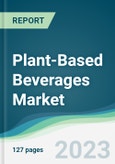The plant-based beverages market is projected to witness a compound annual growth rate of 8.42% to grow to US$ 47.046 billion by 2028 from US$26.708 billion in 2021.
The plant-based beverages market is anticipated to grow significantly in the projected period due to multiple reasons such as shifting consumer preferences and increased awareness about vegan and vegetarian diets, majorly among the millennials. Further, the presence of food allergies and lactose intolerance among children and adults will impact the food preferences of consumers supporting the market growth. For instance- China having one of the largest lactose intolerance populations can become a major destination for generating higher revenue from plant-based beverages in Asia. Additionally, in 2020 according to the National Institute of Diabetes and Digestive and Kidney Diseases, around 65% of the world population is reported to be lactose intolerant.Growing Beverage Industry And Rising Vegan Population
The market will continue to witness a significant boost due to their nutritional properties and health-related benefits for consumers. The increasing health consciousness among the consumer with the consumption of beverages such as milk and smoothies will be an additional factor. Moreover, in January 2021, a research study by the British Nutrition Foundation (BNF) highlighted that consumers belonging to the young age group between 18 and 40 years are more likely to choose plant-based beverages over other alternatives.According to the estimates from the United Nations Food and Agriculture Organization (FAO) Report 2020, vegetarians in India account for around 500 million and 5 million are strict vegans. This highlights the lowest rate of meat consumption in comparison to other countries which present favorable market conditions that will propel the growth of the plant-based beverages market.
Penetration of E-Commerce Channels
Additionally, the penetration of e-commerce channels will drive the sales of plant-based beverages market in upcoming years. For instance- In 2021, Koita, a Dubai-situated dairy expanded the business with a new website to expand its customer reach in the United States market. The online channels will build a strong network providing the availability of plant-based beverages across the globe.The United States in North America is an Expected Dominant Market
Many people are now aware of the health benefits of plant-based diets, such as a lower risk of heart disease, stroke, type 2 diabetes, and some types of cancer. This is leading more people to switch to plant-based beverages as a healthier alternative to dairy products. For instance, A 2021 survey by the Plant Based Foods Association found that 63% of US consumers are eating more plant-based foods than they were five years ago.Moreover, as reported by the Good Food Institute, there are an estimated 65 million lactose-intolerant people and 5 million dairy-allergic people in the United States. These consumers are looking for plant-based beverages as a lactose-free and dairy-free alternative to dairy milk.
Furthermore, as consumers prioritize sustainability, plant-based beverages are preferred over dairy due to their reduced environmental impact. For instance, Nestlé's Natural Bliss Oat Milk with Fava Bean, introduced in March 2023, blends oats and fava beans, crops more sustainable than dairy cows. Oats use 95% less water than dairy milk, and fava beans require 76% less. Their ability to thrive in diverse soils also boosts resilience against climate change.
The data indicating a population of 85 million dogs and 65 million cats in the United States in 2022 reflects the significant presence of pets in the country. This substantial pet population provides a substantial market for pet vaccines. With a large number of dogs and cats requiring regular vaccinations to maintain their health and prevent the spread of diseases, the growth of the pet vaccine market is expected to be driven by the necessity of meeting the healthcare needs of these pets in the USA.
Key Developments
- In 2020, Asahi Group Holdings announced its launch of a plant-based version of a major product, the Calpis milk drink. Similarly, in 2021, Heartbest Food, a leading food technology company launched its plant-based milk in different flavors such as plain and sugar-free varieties among others.
- In January 2021, Nescafe launched a broad range of new vegan flat white pods in various varieties such as almonds and coconut among others.
- In July 2020, Vita Coco, a leading brand of coconut water announced its launch of a new line of functional coconut water with MCT.
Segmentation:
By Source
- Soy
- Coconut
- Rice
- Others
By Product Type
- Milk
- Plant-based water
- RTD
By Distribution Channel
- Online
- Offline
By Geography
- North America
- United States
- Canada
- Mexico
- South America
- Brazil
- Argentina
- Others
- Europe
- United Kingdom
- Germany
- France
- Spain
- Others
- Middle East and Africa
- Saudi Arabia
- UAE
- Israel
- Others
- Asia Pacific
- Japan
- China
- India
- South Korea
- Indonesia
- Thailand
- Others
Table of Contents
1. INTRODUCTION
2. RESEARCH METHODOLOGY
3. EXECUTIVE SUMMARY
4. MARKET DYNAMICS
5. PLANT-BASED BEVERAGES MARKET ANALYSIS, BY SOURCE
6. PLANT-BASED BEVERAGES MARKET ANALYSIS, BY PRODUCT TYPE
7. PLANT-BASED BEVERAGES MARKET ANALYSIS, BY DISTRIBUTION CHANNEL
8. PLANT-BASED BEVERAGES MARKET ANALYSIS, BY GEOGRAPHY
9. COMPETITIVE ENVIRONMENT AND ANALYSIS
10. COMPANY PROFILES
Companies Mentioned
- The Hain Celestial Group
- Califia Farms
- Pacific Foods of Oregon
- The Whitewave Foods Company
- Pureharvest
- Sunopta
- Blue Diamond Growers
- Ripple Foods
- The Coca Cola Company
Methodology

LOADING...
Table Information
| Report Attribute | Details |
|---|---|
| No. of Pages | 127 |
| Published | October 2023 |
| Forecast Period | 2021 - 2028 |
| Estimated Market Value ( USD | $ 26.71 Billion |
| Forecasted Market Value ( USD | $ 47.05 Billion |
| Compound Annual Growth Rate | 8.4% |
| Regions Covered | Global |
| No. of Companies Mentioned | 9 |









